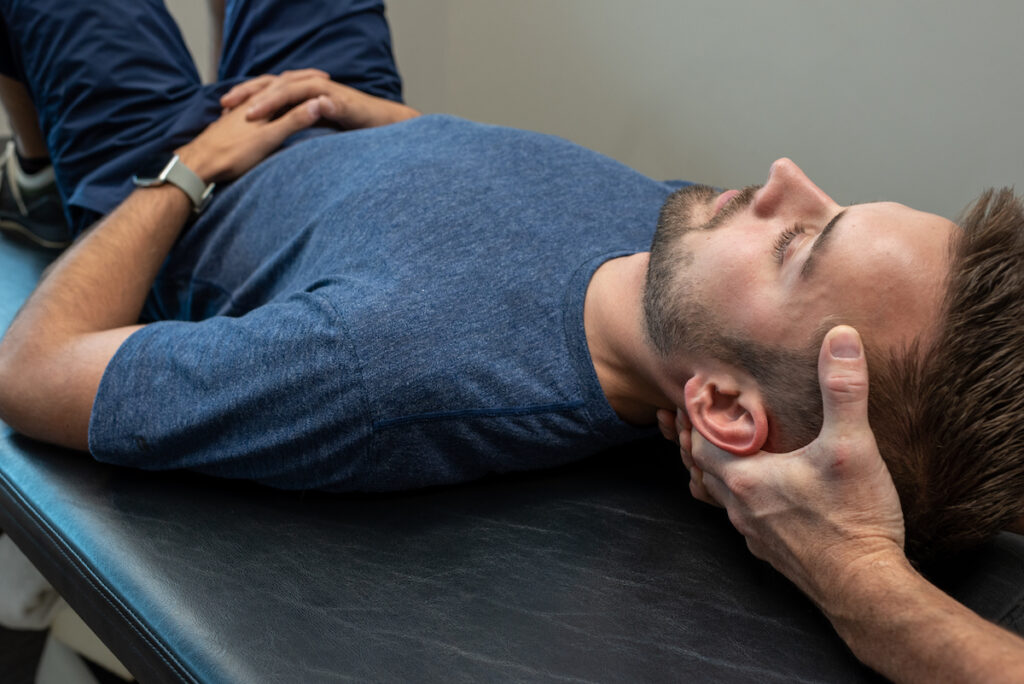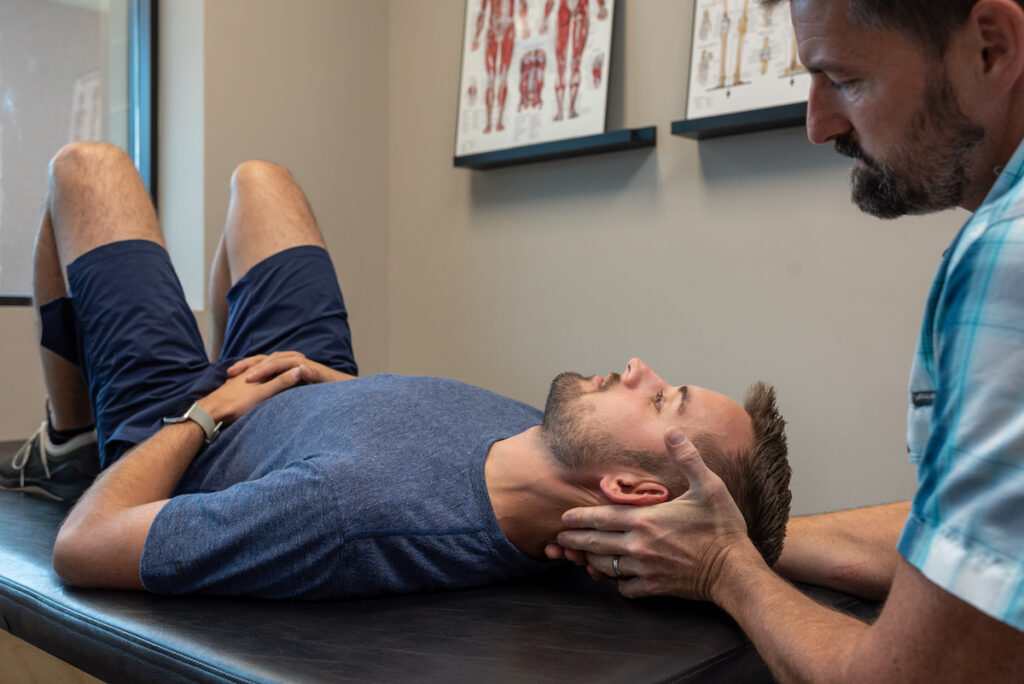
Neck pain has become increasingly common around the world. It has a significant impact on people, their families, communities, healthcare systems, and businesses.
Approximately one third of the population suffers from neck pain at some point in their lives. Neck pain can be quite debilitating, and its effects can range from minor inconveniences to major difficulties. Neck pain can cause serious health issues if not treated properly. Surgical correction may even be necessary in some cases.
When we think of extremities, most people identify our arms and our legs only. What about that thing that projects off of the top of our body? The head and neck are arguably our most important extremity, but many healthcare providers do not even consider it when talking about our limbs. Did you know that our head and neck move with every step and every breath? If the average active American takes 7500-10,000 steps per day and the average person takes over 23,000 breaths per day, consider the impact that could have on how your neck feels having over 30,000 things to do just to keep your head up.
What Does Neck Pain Feel Like?
Neck pain is typically experienced from the base of the head to the top of the shoulders, settling in the back part of the neck. Pain can range from mild to severe and may include dull, constant aches or sharp, stabbing pains.
Other symptoms that may accompany neck pain include:
- Pain and discomfort can interrupt sleep
- Difficulty or inability to fully stand up or sit up straight
- Tingling, numbness, or weakness in your arms
- Headaches
- Tight or stiff upper body muscles
- Pain and discomfort from sitting, lying, or remaining in the same position for too long
We find that neck pain, and the symptoms listed here are more common than people report to their doctor. Even when we are treating other areas of the body like back pain, or pelvic tilt, it is common for patients to tell us that they have a history of neck pain, tension, headache, and tightness or stress in their neck and shoulders. Sometimes people wake up with neck pain and difficulty turning their head. When this happens, people ask about what pillow or mattress they should use to improve the symptoms, but we would rather consider what your neck is trying to do all night for you instead of rest that would cause discomfort.
Common Neck Pain Causes
Many people are using their neck for more than just holding their head up. The muscles of the neck can help move your body forward when your abdominals are weak, or when your hip flexors are tight. Have you ever had a sore neck after trying to work out your abdominal muscles? Also, the neck muscles can be tied directly to poor diaphragmatic breathing. If we breathe over 23,000 times per day, and our diaphragm can not move well, our neck starts to help lift the weight of the chest up. That creates a lot of additional work and pulling of the muscles down on the segments of the neck bones. We see and treat this source of neck pain every day. Consider this especially if you also have acid reflux, hiatal hernia, clench or grind your teeth (bruxism), anxiety, shortness of breath, or a barrel shaped chest.
- Aging: As we get older, degenerative conditions such as osteoporosis (loss of bone density), arthritis (inflammation of joints), and spinal stenosis (a narrowing of the spaces in the back of the spine) can cause neck pain. Over time, stress or repetitive motions can cause spinal discs to deteriorate, leading to a herniated disc (a bulging disc) or pinched nerve.
- Injury: A trauma to the neck or head can result in injury and pain. Whiplash injuries are common after car accidents, for example. Trauma injuries to the spinal cord may affect the muscles, ligaments, disks, vertebral joints, and nerve roots in the neck.
- Bad posture: Sitting for long periods of time, poor keyboard/computer/chair positioning, being overweight, and weak abdominal muscle strength can all affect your posture and contribute to chronic neck pain.
- Temporomandibular joint disorders (TMJD): TMJ can cause referred pain in various forms including headaches, neck pains, shoulder aches, and more.
- Stress: Stiffness caused by tight neck muscles due to mental stress can often lead to neck pain and soreness.
- Straining: Repeatedly using your neck muscles for long periods of time can cause stiffness and pain.
- Other health conditions that can cause neck pain include meningitis, rheumatoid arthritis, and cancer. Rarely, masses including tumors, bones, cysts and bone spurs can cause neck pain.
When Physical Therapy May Be Recommended for Neck Pain

There are many reasons why physical therapy may be recommended for people experiencing neck pain – some of the most common reasons are listed below.
Chronic pain: When neck pain persists or recurs, the exact cause may be hard to pinpoint. Without a diagnosis, strengthening the muscles of the neck could be helpful for supporting the cervical spine and becoming less susceptible to pain.
After surgery: Neck surgery may cause some pain and stiffness for several weeks or months afterwards. If these symptoms persist, then physical therapy might be helpful for reducing stiffness, increasing neck function, and preventing painful muscle spasms.
After an injury: Some types of injuries, such as whiplash, can damage the neck’s soft tissue and joints, causing pain and/or stiffness lasting for weeks or months or sometimes years. Physical therapy programs can reduce pain and help restore normal function to the neck.
When all of these reasons for treatment lead us to more questions like why is the pain chronic or why did the neck need surgery. The greatest source of compression in the neck is tension. Tension comes from muscle contraction pulling down on the joints and discs of the neck. Compression also creates irritating friction in the joint surfaces and can lead to degeneration and arthritis. Physical therapy for neck pain can work best when the therapist considers what these muscles are having to do causing contraction and overuse. Some questions to ask yourself or your therapist is: Do I use my neck more on one side than the other? If you always prefer to stand on or cross one leg you do! You can not lean your body to one side without leaning your head to the other. Is one shoulder lower than the other? Same result! A physical therapist at SIMIO Physical Therapy can show you why your body is doing this.
The Goals of Physical Therapy for Neck Pain

A lot of neck symptoms can be improved with stretching, strengthening, and posture correction, but how do we keep these things from returning. A SIMIO goal for improving and maintaining progress is to make the work of holding your head up for every step and every breath easier. This requires your provider to understand a complex task – balancing balls on top of balls. Picture this, you stack a basketball, a soccer ball, and a tennis ball from largest on the bottom to the smallest on top like a snowman. Now let go! Would they fall? If you rolled the bottom ball, would the top ball roll too? What happens to the top and bottom ball when you roll the middle ball? We are all connected and balancing the head on top of the shoulders requires the whole body to understand the challenge.
Reduce pain and stiffness
Improving strength and flexibility in the muscles of the neck can help to reduce pain and improve posture, which will reduce stress on the cervical spine, thus reducing back pain.
Improve head and neck range of motion
Physical therapy is important for helping you improve your range-of-motion. Increased range of motion can be achieved by increasing both strength and flexibility. A physical therapist can help you perform a series of stretches and exercise to achieve this.
Strengthening the neck and its supporting musculature
Physical Therapy can help to improve your posture, which can either eliminate or greatly relieve neck pain. You can work with your PT to retrain the muscles in the chest and the front and back of your neck, so that they will be strong enough to support good posture.
Patient education to help prevent pain from recurring
You shouldn’t just stop practicing good posture once you’re done with your physical therapy session; you should continue doing so at home too. It’s important for you to know that the things you do everyday can be contributing factors to your neck pain. You can learn how to maintain good posture through physical therapy. Even small changes to your behavior can help prevent neck pain in the future.
The SIMIO Approach to Neck Pain Physical Therapy
SIMIO therapists look at the movement of the body from the inside-out. What can we do from our center to make less work for the neck rather than only applying stretch or a thrust to the outside of the neck to create a change. Could we make the neck free to move by reducing the challenges it faces to balance or breathe? Could we put the neck into a position that it is happy in to create change rather than pull our head into contorted postures to find a stretch? Remember, the head always wants to be straight up and straight forward so that the eyes are centered and the ears are level. This is what prevents us from getting dizzy or disoriented. Try bobbing or turning your head back and forth while you walk. You would rather not. It is the neck’s responsibility to level things when the body is in motion and for as long as it is still breathing. Are you breathing?

Craig E. Stasio
PT, MSPT, PRC™, AIA Fellow
Craig E. Stasio is a 2004 graduate of Grand Valley State University’s Graduate Physical Therapy program. Craig has worked in the physical therapy field since 1998 and has served as an aide, lead PT, and Director of Clinical Services and clinical educator prior to starting his own private specialty practice in 2008.

Nate Dykema
PT, DPT, Cert MDT
Nate Dykema is a 2011 graduate of Grand Valley State University’s Doctorate Physical Therapy program. Nate is a certified provider of the McKenzie Method of Mechanical Diagnosis and Therapy, and is actively engaged in PRI coursework and the study of patterned human asymmetry.
Let’s discuss your goals during a free consultation
Correcting poor alignment, postural awareness, or improving your ability to move starts with discovering what is limiting your body’s ability. We’ll examine your whole body for imbalanced relationships that lead to undesired tension, restriction or altered movement. Then we’ll create a roadmap to help you overcome your limits and build an awareness that leads to lasting results.
Arrange a meeting with a licensed physical therapist in Zeeland, MI today.